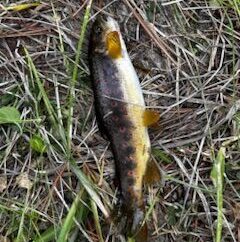
The Fall fishing bite has arrived in the Kern River Valley! Big bass and magnificent trout are back. With the cooler weather, we are seeing an increase in fish activity, with longer biting windows. The cooler temperatures will continue to drop and knock on wood—hot weather is gone for the rest of the year.
Now that the bite is returning think about your tackle, rod size, line, and where you are fishing. With smaller streams, like creeks, you want a light line with a smaller bait or fly. You will need a different setup on Lake Isabella compared to your creek/river rod and reel. Additionally, think about when you are getting to the water and casting out.
I have experienced good luck in the early morning hours on the creeks and rivers. Lower Peppermint Creek has been an exceptional spot for me over the season, allowing me to develop as an angler. Creeks are my favorite to fish because of the challenges that arise when you are fishing.
Salmon Creek is a lovely drive-up Mountain Road 99 to Sherman Pass road. I love it up there, where the citrus smell of pines and the melodic creek’s restorative energy wash away the modern world’s stress and anxiety.
At Salmon Creek, planning your game is beneficial; if I am not using a fly, mealworms do an excellent job coaxing trout to bite. Floating your offering on the water surface is the move here, with a light line, small size 14 hooks, and no weight. I also only let a little line out, maybe 10 feet at the most, since creeks typically have overhead snag issues and side casting is problematic; a front flick of the line into the water works well and offers less chance of wasting time snags.
Since trout face upstream, you will want to approach from downstream, so be careful not to cast a shadow on the water while paying attention to your rod tip and foot placement. The last thing you want is a broken rod tip or a misplaced foot to land in the creek. So, do your best to avoid wet socks, a broken rod tip, and scaring trout out of an area.
Polarized sunglasses are a useful angling tool to avoid glare. Glare can come from a few different sources – sun, water, and sand. Polarized glasses remove the glare and allow you to see fish more clearly. This is a considerable advantage for shallow water because it expedites catching and eschews less time wasted on dead holes. More importantly, polarized sunglasses distinguish between seeing your line and not seeing your line. If your line is not moving, you’re not fishing, and seeing your line is the difference between catching and fishing.
Whether you are fishing the creeks and rivers or at the lake, planning out your game is a tactic that will yield results. Planning is all the difference between going home with a caught dinner or stopping at the grocery store. So, research where you want to fish, watch internet videos, or read blogs on the areas you want to visit; putting in the work, planning out your tackle, and learning an area’s secrets will lead to hefty stringers.
Remember my friends, tight lines and leave-no-trace.





